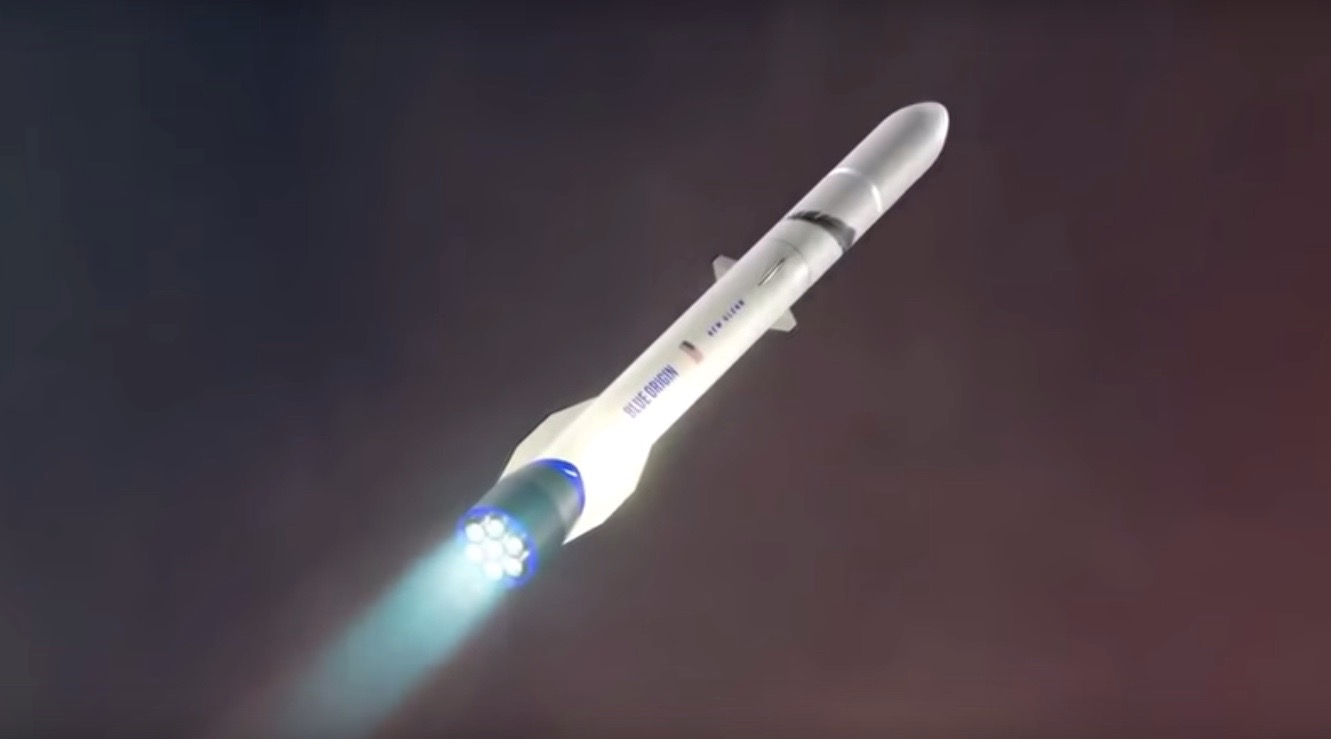Blue Origin Video Shows Off Updated Design of Huge New Glenn Rocket
A new video shows the latest design incarnation of Blue Origin's huge New Glenn rocket, which is scheduled to debut in 2021.
Blue Origin, which is led by Amazon.com founder Jeff Bezos, released the nearly 2-minute animation on Wednesday (Jan. 16). It shows highlights of a typical mission for the two-stage heavy-lifter, including a first-stage landing on a ship at sea — a dramatic maneuver made famous by returning first stages of SpaceX Falcon 9 rockets.
There are a few notable differences between the rocket depicted in the new video and the New Glenn we saw in a similar 2017 animation. For example, the older version featured a payload fairing — the protective nose cone that surrounds spacecraft during launch — that was bullet-shaped and 18 feet (5.4 meters) wide. The current incarnation boasts a 23-foot-wide (7 m) fairing with a traditional snub-nosed look. (A previously envisioned three-stage New Glenn featured this bigger fairing, but this booster variant is no longer part of Blue Origin's plans.) [Blue Origin's Giant New Glenn Rocket in Pictures]

And the first stage's six landing legs will apparently now deploy a bit differently — by unfolding outward from the bottom, much as Falcon 9 legs do, rather than sort of sliding downward.
There are some cosmetic changes, too. The rocket's new livery has more of a black-and-white look, with fewer blue highlights, and a smaller version of Blue Origin's feather symbol.
New Glenn — which takes its name from NASA astronaut John Glenn, who in February 1962 became the first American to orbit Earth — will be an immense and powerful rocket. It will stand 313 feet (95 m) tall and be capable of lofting 50 tons (45 metric tons) to low Earth orbit (LEO). The first stage is designed to fly at least 25 times, Blue Origin representatives have said.
For comparison, SpaceX's 230-foot-tall (70 m), two-stage Falcon Heavy rocket, which made its debut flight in February 2018, can haul 70.3 tons (63.8 metric tons) of payload to LEO. (The Falcon Heavy's first stage consists of three modified Falcon 9 cores, all of which are designed to land and fly again.)
Get the Space.com Newsletter
Breaking space news, the latest updates on rocket launches, skywatching events and more!
NASA is working on its own heavy-lifter, to help get astronauts to the moon, Mars and other distant destinations. This rocket, called the Space Launch System (SLS), will be the most powerful ever built, boasting even more thrust than the famous Apollo-era Saturn V, NASA officials have said.
The SLS is scheduled to fly for the first time in June 2020, on a mission that will send an uncrewed Orion capsule on a journey around the moon.
Mike Wall's book about the search for alien life, "Out There" (Grand Central Publishing, 2018; illustrated by Karl Tate) is out now. Follow him on Twitter @michaeldwall. Follow us @Spacedotcom or Facebook. Originally published on Space.com.
Join our Space Forums to keep talking space on the latest missions, night sky and more! And if you have a news tip, correction or comment, let us know at: community@space.com.

Michael Wall is a Senior Space Writer with Space.com and joined the team in 2010. He primarily covers exoplanets, spaceflight and military space, but has been known to dabble in the space art beat. His book about the search for alien life, "Out There," was published on Nov. 13, 2018. Before becoming a science writer, Michael worked as a herpetologist and wildlife biologist. He has a Ph.D. in evolutionary biology from the University of Sydney, Australia, a bachelor's degree from the University of Arizona, and a graduate certificate in science writing from the University of California, Santa Cruz. To find out what his latest project is, you can follow Michael on Twitter.









